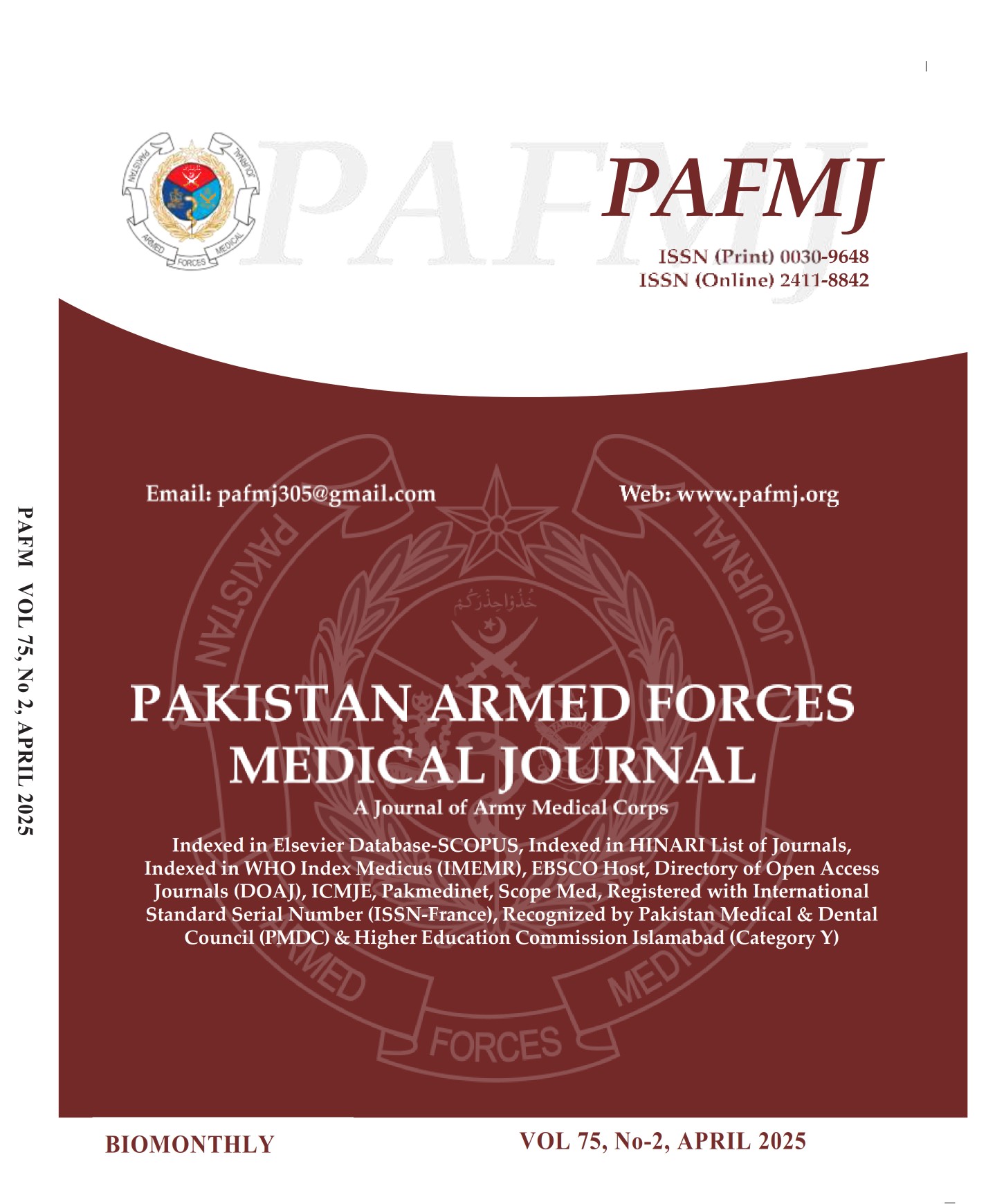Role of Intrastromal Bevacizumab in Reducing Corneal Neovascularization in Patients Presenting to a Tertiary Care Hospital in Multan
DOI:
https://doi.org/10.51253/pafmj.v75i2.9698Keywords:
Bevacizumab; corneal neovascularization (CNV); intrastromal injection.Abstract
Objective: To assess the effect of a single dose of intrastromal Bevacizumab on anomalous corneal neovessels in patients with corneal neovascularization.
Study Design: Quasi-experimental study.
Place and Duration of Study: Combined Military Hospital Multan, Pakistan from Apr to Sep 2022.
Methodology: After taking informed consent, up to 0.1ml intrastromal injection of Bevacizumab (25mg/ml) was given to 50 eyes with Grade 3 or Grade 4 corneal neovascularization (The primary outcome measure was to assess the efficacy of a single dose of intrastromal Bevacizumab by assessing the decrease in the area of corneal neovascularization at the end of 6 weeks.
Results: At the end of 6 weeks, regression and downgrading of corneal neovascularization were seen. Of the 23 eyes with Grade 4 corneal neovascularization, 21(91.3%) eyes were downgraded to Grade 3, and two eyes (8.69%) were downgraded to Grade 2. Of the 27 eyes with Grade 3 corneal neovascularization, 25 were downgraded to Grade 2(92.6%), and two were downgraded to Grade 1(7.4%). There was a significant decrease in the area of corneal neovascularization from 2.88±0.50 mm before injection and 1.83±0.54 mm after Bevacizumab (p=0.001).
Conclusion: Intrastromal administration of a single dose of Bevacizumab reduced the invasion area of corneal neovascularization at the end of six weeks. The degree of reduction of neovascularization was also dependent on the Grade of corneal neovascularization. Intrastromal Bevacizumab is an effective treatment for corneal neovascularization with minimum local and systemic side effects.
Downloads
References
Qazi Y, Wong G, Monson B, Stringham J, and Balamurali K. Corneal transparency: genesis, maintenance and dysfunction Brain Res Bull 2010; 81(2-3): 19.
https://doi.org/10.1016/j.brainresbull.2009.05.019
Azar DT. Corneal angiogenic privilege: angiogenic and antiangiogenic factors in corneal avascularity, vasculogenesis, and wound healing Trans Am Ophthalmol Soc 2006;104:264–302.
Liesegang TJ. Physiologic changes of the cornea with contact lens wear. CLAO J 2002; 28(1): 12-27.
Hamill MB. Corneal and scleral trauma. Ophthalmol Clin North Am 2002; 15: 185–194.
https://doi:10.1016/s0896-1549(02)00018-4
Cursiefen C, Kuchle M, Naumann GO. Angiogenesis in corneal diseases: histopathologic evaluation of 254 human corneal buttons with neovascularization. Cornea 1998; 17: 611–613.
https://doi: 10.1097/00003226-199811000-00008
Elbaz U, Mireskandari K, Shen C, Ali A. Corneal Fine Needle Diathermy With Adjuvant Bevacizumab to Treat Corneal Neovascularization in Children. Cornea 2015; 34(7): 773–777.
https://doi:10.1097/ICO.0000000000000419
Brooks BJ, Ambati BK, Marcus DM, Ratanasit A. Photodynamic therapy for corneal neovascularisation and lipid degeneration. Br J Ophthalmol 2004; 88: 840. https://doi: 10.1136/bjo.2003.035071
Gan L, Fagerholm P, Palmblad J. Vascular endothelial growth factor (VEGF) and its receptor VEGFR-2 in the regulation of corneal neovascularization and wound healing. Acta Ophthalmol Scand 2004; 82: 557–563.https://doi: 10.1111/j.1600-0420.2004.00312.x
Schmidt-Erfurth UM, Richard G, Augustin A, Aylward WG, Bandello F, Corcostegui B, et al. Guidance for the treatment of neovascular age-related macular degeneration. Acta Ophthalmol Scand 2007; 85: 486–94.
htttps://doi:10.1111/j.1600-0420.2007.00979.x
Krizova D, Vokrojova M, Liehneova K. Treatment of Corneal Neovascularization Using Anti-VEGF Bevacizumab. J Ophthalmol 2014: 178132.https://doi.org/10.1155/2014/178132
Usui T, Yamagami S, Kishimoto S, Seiich Y, Nakayama T, Amano S et al. Role of macrophage migration inhibitory factor in corneal neovascularization. Invest Ophthalmol Vis Sci 2007; 48: 3545–3550.
https://doi:10.1186/s12348-023-00361-2
Bock F, Konig Y, Kruse F, Baier M, Cursiefen C. Bevacizumab (Avastin) eye drops inhibit corneal neovascularization. Graefes Arch Clin Exp Ophthalmol 2008; 246: 281–284.
https://doi: 10.1007/s00417-007-0684-4
You IC, Kang IS, Lee SH, Yoon KC. Therapeutic effect of subconjunctival injection of Bevacizumab in the treatment of corneal neovascularization. Acta Ophthalmol 2009; 87(6): 653-658. https://doi.org/10.1111/j.1755-3768.2008.01399.x
Maddula S, Davis DK, Maddula S, Burrow MK, Ambati BK. Horizons in therapy for corneal angiogenesis. Ophthalmology 2011; 118(3): 591-599. https://doi: 10.1016/j.ophtha.2011.01.041
Chang JH, Garg NK, Lunde E, Han KY, Jain S, Azar DT et al. Corneal neovascularization: An anti-VEGF therapy review. Surv Ophthalmol 2012; 57(5): 415-429.
https://doi: 10.1016/j.survophthal.2012.01.007
Vieira AC, Höfling-Lima AL, Gomes JÁ, de Freitas D, Farah ME, Belfort R Jr et al. Intrastromal injection of Bevacizumab in patients with corneal neovascularization. Arq Bras Oftalmol 2012; 75(4): 277-279. https://doi:10.12659/AJCR.906506
Koenig Y, Bock F, Kruse FE, Stock K, Cursiefen C. Angioregressive pretreatment of mature corneal blood vessels before keratoplasty: Fine-needle vessel coagulation combined with anti-VEGFs. Cornea 2012; 31(8): 887-892.
https://doi: 10.1097/ICO.0b013e31823f8f7a
Mohammadpour M. Deep intrastromal injection of Bevacizumab for the management of corneal neovascularization. Cornea 2013; 32(1): 109–110.
https://doi: 10.1097/ICO.0b013e318262e872
Hashemian MN, Zare MA, Rahimi F, Mohomadpour M (2011) Deep intrastromal Bevacizumab injection for management of corneal stromal vascularization after deep anterior lamellar keratoplasty, a novel technique. Cornea 2011; 30(2): 215–218.
https:// doi:10.1097/ICO.0b013e3181e291a6
Gupta AA, Mammo DA, Michael A. “Intrastromal Bevacizumab in the Management of Corneal Neovascularization: a Retrospective Review.” Graefe’s Arch Clin Exp Ophthalmol 2020: 167–173.
https://doi:10.1007/s00417-019-04519-4
Yeung SN, Lichtinger A, Kim P, Amiran MD, Slomovic AR (2011) Combined use of subconjunctival and intracorneal Bevacizumab injection for corneal neovascularization. Cornea 2011; 30(10): 1110–1114.
https://doi: 10.1097/ICO.0b013e31821379aa
Vieira AC, Höfling-lima AL, Gomes JÁ, Dd F, Farah ME, Belfort R et al. Intrastromal injection of Bevacizumab in patients with corneal neovascularization. Arq Bras Oftalmol 2012; 75(4): 277–279.
https://doi.org/10.1007/s00417-019-04519-4
Sarah B, Ibtissam H, Mohammed B, Hasna S, Abdeljalil M. Intrastromal Injection of Bevacizumab in the Management of Corneal Neovascularization: About 25 Eyes. J Ophthalmol 2016; 2016: 6084270.
https://doi: 10.1155/2016/6084270
Stevenson W, Cheng SF, Dastjerdi MH, Ferrari G, Dana R. Corneal neovascularization and the utility of topical VEGF inhibition: ranibizumab (Lucentis) vs Bevacizumab (Avastin). Ocul Surf 2012; 10(2): 67-83.
https://doi: 10.1016/j.jtos.2012.01.005
Bayo-Calduch P, Vila-Arteaga J, MaríCotino JF. Fine needle diathermy and intraestromal Bevacizumab : A combined treatment for corneal neovascularization. Ophthalmol Open J 2016; 1(1): 17-20. https://doi: 10.17140/OOJ-1-105
Downloads
Published
Issue
Section
License
Copyright (c) 2025 Kashif Ali, Muhammad Khizer Niazi, Saad Mushtaq Malik, Mehmood Riaz, Danish Javeed, Muhammad Waqas

This work is licensed under a Creative Commons Attribution-NonCommercial 4.0 International License.















